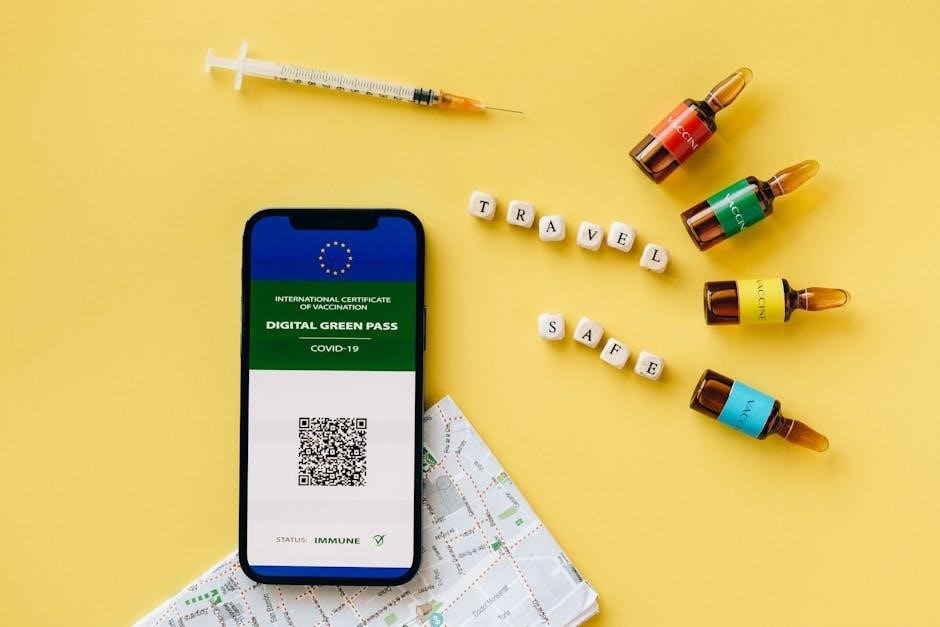Nursing concept maps are visual tools that organize and connect key nursing concepts, aiding in education and clinical practice by simplifying complex patient care information.
1.1 Definition and Purpose of Nursing Concept Maps
Nursing concept maps are visual tools that organize and connect key concepts, diagnoses, and interventions. They provide a structured framework to visualize patient care processes, aiding in education and clinical practice. These maps help nurses and students understand relationships between symptoms, diagnoses, and treatments, improving care planning and critical thinking. Their purpose is to simplify complex information, making it easier to assess, diagnose, and implement effective patient care strategies.
1.2 Importance of Concept Maps in Nursing Education
Nursing concept maps are invaluable in education, helping students visualize complex relationships between diagnoses, symptoms, and treatments. They enhance critical thinking and problem-solving skills by organizing information logically. These tools also aid in memorization and retention of key nursing concepts, making studying more efficient. By fostering a deeper understanding of patient care processes, concept maps prepare students for real-world clinical scenarios, bridging the gap between theory and practice effectively.

Benefits of Using Nursing Concept Maps
Nursing concept maps offer organized visualization of patient care, enhance learning, and improve critical thinking. They simplify complex information, aiding in care planning and clinical decision-making effectively.
2.1 Enhanced Organization of Nursing Knowledge
Nursing concept maps provide a structured framework for organizing complex nursing information. By visually connecting key concepts, symptoms, diagnoses, and treatments, they simplify knowledge retention. These tools help students and professionals categorize patient data, facilitating easier access and retrieval during clinical practice. The templates allow for the mapping of patient problems, contributing factors, and interventions, ensuring a coherent and systematic approach to care planning and delivery.
2.2 Improved Critical Thinking and Problem-Solving Skills
Nursing concept maps enhance critical thinking by visually connecting patient symptoms, diagnoses, and treatments. This structured approach helps nurses analyze complex patient data, identify relationships, and prioritize interventions. By breaking down information into manageable components, concept maps foster deeper understanding and effective decision-making, enabling nurses to develop tailored care plans and improve patient outcomes through logical reasoning and problem-solving.
2.3 Visual Learning for Complex Nursing Concepts
Nursing concept maps provide a visual framework for understanding intricate patient care scenarios. By using colors, symbols, and diagrams, they simplify complex relationships between symptoms, diagnoses, and treatments. This visual approach enhances retention and comprehension, making it easier for nursing students and clinicians to grasp difficult concepts. Visual learning tools like concept maps are particularly effective for breaking down multifaceted patient information into clear, actionable insights, improving overall learning outcomes in nursing education and practice.
Step-by-Step Guide to Creating a Nursing Concept Map
Download a template, identify patient problems, organize information, and connect ideas to create a clear visual representation of patient care, ensuring a structured and effective learning tool.
3.1 Downloading a Nursing Concept Map Template
Start by downloading a printable nursing concept map template, available as a free PDF. These templates are designed to help organize symptoms, diagnoses, and treatments visually. They are non-modifiable but can be filled digitally or printed for handwritten notes. Templates often include sections for patient demographics, contributing factors, and care plans. Download from trusted sources like Carepatron or NURSING.com to ensure quality and relevance. This step simplifies the creation process and provides a structured format for mapping nursing concepts effectively.
3.2 Identifying Patient Problems and Key Concepts
Gather relevant patient information, including demographics and medical history, to identify primary issues. Determine contributing factors, symptoms, and diagnostic data. Highlight key nursing concepts such as diagnoses, interventions, and patient education. This step ensures the concept map addresses all aspects of care, making it a comprehensive tool for understanding and managing patient conditions effectively. Organizing these elements lays the foundation for a clear and actionable map.
3.3 Organizing Information and Connecting Ideas
Arrange identified problems and concepts hierarchically, starting with the main diagnosis. Use arrows, boxes, and text to link related ideas, showing relationships between symptoms, treatments, and outcomes. This visual structure helps in understanding care flows and prioritizing interventions. Ensure each connection is logical and clear, making the map an intuitive guide for clinical decision-making and patient care planning.
3.4 Finalizing and Reviewing the Concept Map
After organizing, review the map for accuracy and completeness. Ensure all patient issues are addressed and interventions are realistic. Check for logical flow and clarity, making adjustments as needed. Export the map as a PDF for easy sharing or printing. Regularly update the map with new information to reflect evolving patient needs and care plans, ensuring it remains a relevant and effective clinical tool.

Popular Nursing Concept Map Templates
Popular templates include printable PDFs, nursing diagnosis maps, and body system-based designs. These tools are free, easy to download, and customizable for various nursing needs and studies.
4.1 Printable Nursing Concept Map Template
A printable nursing concept map template is a valuable tool for organizing symptoms, diagnoses, and treatments. Available as a PDF, it offers a structured format for both digital and handwritten use. These templates are non-modifiable but provide a clear framework for nursing students and educators to visualize patient care concepts effectively. They are easily downloadable and ideal for studying, note-taking, and clinical planning, making complex information more accessible and organized.
4.2 Nursing Diagnosis and Care Plan Concept Map
A nursing diagnosis and care plan concept map is a comprehensive tool that outlines a patient’s entire care journey. It includes assessments, diagnoses, interventions, and evaluations, providing a clear visual pathway for patient care. This template is ideal for organizing complex patient information, ensuring coherence and effectiveness in care delivery. It is often used by students and professionals to streamline care planning and enhance clinical decision-making skills through structured visualization.
4.3 Body System-Based Concept Map Template
A body system-based concept map template is designed to organize nursing knowledge around specific physiological systems, such as cardiovascular or respiratory. This template helps visualize how diseases, symptoms, and treatments interact within each system, making it easier to understand complex relationships. It is particularly useful for students and professionals to study and apply system-specific care, enhancing both education and clinical practice effectiveness.

Types of Nursing Concept Maps
Nursing concept maps vary, offering specialized approaches like patient-centered, disease-specific, and pharmacology-based designs, each tailored to address unique aspects of nursing care and education.
5.1 Patient-Centered Concept Maps
Patient-centered concept maps focus on individualized care, emphasizing the patient’s unique needs, symptoms, and outcomes. These maps integrate assessments, diagnoses, and interventions, providing a holistic view of care. They are particularly useful in clinical settings, allowing nurses to visualize the patient’s journey and tailor interventions effectively. By prioritizing the patient’s specific health issues, these maps enhance personalized care and improve clinical decision-making.
5.2 Disease-Specific Concept Maps
Disease-specific concept maps are tailored to particular conditions, detailing symptoms, diagnostics, treatments, and patient education. These maps are essential for nurses to master disease processes, linking pathophysiology with nursing interventions. They simplify complex information, making it easier to understand and apply in real-world scenarios, thus improving care quality for patients with specific conditions like diabetes or heart failure.
5.3 Pharmacology and Medication Concept Maps
Pharmacology and medication concept maps visually organize drug interactions, side effects, and nursing interventions. They help nurses understand drug classifications, mechanisms of action, and patient education; These maps simplify complex medication regimens, ensuring safe administration and monitoring. By linking drugs to patient outcomes, they enhance medication management skills and improve patient safety in clinical settings.

Incorporating Concept Maps into Clinical Practice
Concept maps streamline clinical decision-making by organizing patient data, diagnoses, and interventions. They enhance communication and care coordination, ensuring comprehensive and patient-centered care delivery.
6.1 Assessments and Diagnoses
Concept maps facilitate thorough patient assessments by visually connecting symptoms, lab results, and medical history. They aid nurses in identifying primary and secondary diagnoses, ensuring accurate and timely care plans. By structuring data effectively, these tools enhance diagnostic accuracy and streamline the decision-making process, making them invaluable in clinical settings for improving patient outcomes.
6.2 Interventions and Patient Education
Concept maps guide the development of tailored interventions, outlining specific treatments and medications. They also serve as educational tools for patients, visually explaining diagnoses, care plans, and self-management strategies. This clear communication enhances patient understanding and adherence to treatment, fostering better health outcomes and empowering patients in their care journey.
6.3 Evaluation and Outcome Measurement
Concept maps facilitate the evaluation of patient progress by visually tracking outcomes against set goals. They enable nurses to assess the effectiveness of interventions and document care plan adjustments. This tool also aids in measuring the attainment of expected outcomes, providing a clear framework for reflecting on practice and improving future care delivery.

Best Practices for Designing Effective Concept Maps
Ensure clarity and simplicity by using relevant colors, symbols, and concise labels. Focus on organizing information logically and maintaining visual appeal to enhance understanding and practical application.
7.1 Clarity and Simplicity in Design
Clarity and simplicity are essential for effective concept maps. Use clear labels, avoid clutter, and ensure each element serves a purpose. Opt for straightforward language and minimalistic designs to enhance readability. Incorporate colors and symbols thoughtfully to highlight key points without overwhelming the viewer. This approach ensures the map remains focused, visually appealing, and easy to interpret, making it a valuable tool for nursing education and practice.
7.2 Using Colors and Symbols Effectively
Using colors and symbols in concept maps enhances visual appeal and organization. Choose colors that differentiate concepts without overwhelming the viewer. Symbols like arrows, boxes, and icons can represent relationships and ideas. Consistency is key to avoid confusion. For example, use red for priority areas or green for positive outcomes. These elements guide the viewer’s attention and make complex information more digestible, ensuring the map is both functional and visually engaging.
7.3 Ensuring Relevance to Nursing Practice
Concept maps must align with real-world nursing scenarios to remain effective. Focus on patient-centered care by linking symptoms, diagnoses, and interventions. Use relevant clinical examples to ground the map in practical application. Customize templates to address specific patient needs, ensuring the content directly supports care planning and decision-making. This approach bridges theory and practice, making the map a valuable tool for improving patient outcomes and streamlining nursing workflows.

Tools and Software for Creating Nursing Concept Maps
Popular tools like Creately and digital templates enable easy creation of nursing concept maps. These platforms offer drag-and-drop features, customizable designs, and PDF export options for seamless sharing and printing.
8.1 Digital Tools for Concept Map Creation
Digital tools like Creately, MindMeister, and Lucidchart simplify concept map creation with user-friendly interfaces. These platforms offer drag-and-drop features, customizable templates, and real-time collaboration. Nurses and students can easily organize patient data, diagnoses, and care plans. Many tools support PDF exports, making it easy to share and print maps. These digital solutions enhance productivity and provide accessible ways to visualize complex nursing concepts effectively.
8.2 Printable Templates for Handwritten Maps
Printable templates for nursing concept maps are widely available as free PDF downloads, offering a structured format for handwritten notes. These templates help organize symptoms, diagnoses, and treatments, making studying more efficient. Designed for nursing students and professionals, they provide a clear framework for visualizing patient care. Popular sources like Carepatron and Creately offer customizable options, ensuring ease of use and adaptability to individual learning needs.
8.3 Exporting and Sharing Concept Maps as PDF
Exporting nursing concept maps as PDFs allows for high-quality sharing and printing. Tools like Creately enable easy PDF exports, making it simple to share maps via email or cloud storage. This feature is particularly useful for collaborating with colleagues, presenting care plans, or distributing study materials. PDFs ensure that concept maps remain clear and professional, facilitating effective communication in both educational and clinical settings.

Case Studies and Examples
Real-world examples of nursing concept maps demonstrate their practical application in patient care and education. These case studies highlight how maps organize complex information, aiding in diagnoses, care planning, and student learning.
9.1 Example of a Nursing Care Plan Concept Map
A nursing care plan concept map visually outlines a patient’s entire care journey, from assessments and diagnoses to interventions and evaluations. It organizes symptoms, treatments, and patient education, providing a clear framework for care. Printable PDF templates, like those from Carepatron, offer customizable layouts, allowing nurses to tailor maps to specific cases, enhancing both education and clinical decision-making. These tools are invaluable for students and professionals alike, simplifying complex care plans and fostering better patient outcomes.
9.2 Concept Map for a Medical Diagnosis
A concept map for a medical diagnosis visually organizes patient data, symptoms, lab results, and treatments, aiding nurses in identifying patterns and prioritizing care. Starting with the primary diagnosis, it branches into contributing factors, medications, and interventions. Printable PDF templates simplify creation, allowing customization for specific conditions. These maps enhance critical thinking, ensuring comprehensive and accurate diagnoses, and are invaluable for both education and clinical practice in nursing.
9.3 Real-World Applications in Nursing Education
Nursing concept maps are widely used in education to help students visualize patient care plans, disease processes, and pharmacology. Free PDF templates enable students to create customizable maps, enhancing their understanding of complex topics. These tools are particularly effective for studying challenging subjects, as they provide a clear, organized framework for linking symptoms, diagnoses, and interventions. This visual approach fosters better retention and application of nursing knowledge in real-world clinical settings.

Challenges and Solutions in Using Concept Maps
Challenges include information overload and ensuring accuracy. Solutions involve using templates, focusing on relevant details, and verifying content through reliable sources to maintain clarity and effectiveness.
10.1 Overcoming Information Overload
Managing excessive information is crucial for effective concept mapping. Start by focusing on patient-centered data, prioritizing key concepts, and using templates to streamline content. Simplify by eliminating non-essential details and organizing ideas hierarchically. Use visuals like colors and symbols to enhance clarity. Regularly review and refine maps to ensure they remain concise and relevant, improving both learning and clinical application. This approach helps maintain focus and reduces complexity.
10.2 Ensuring Accuracy and Relevance
Accuracy and relevance are critical in nursing concept maps. Use reliable sources like medical guidelines and patient data to validate information. Involve clinical expertise to ensure content aligns with best practices. Regularly update maps to reflect current evidence-based care. Clearly define concepts and relationships to avoid ambiguity. Ensure templates are tailored to specific patient needs, focusing on actionable interventions and outcomes. This maintains the map’s effectiveness and reliability in clinical settings.
10.3 Time Management for Creating Maps
Effective time management is essential when creating nursing concept maps. Start with clear objectives and prioritize key concepts. Use pre-designed templates to save time on formatting. Allocate specific time blocks for brainstorming, organizing, and reviewing. Focus on simplicity and avoid unnecessary details. Regular practice improves efficiency, enabling nurses to create maps quickly while maintaining quality. Balancing thoroughness with timeliness ensures maps remain practical tools for patient care and education.
Nursing concept maps are invaluable tools for organizing knowledge, enhancing critical thinking, and improving patient care. Their versatility and visual appeal make them essential for education and clinical practice, fostering better outcomes and continuous learning in nursing.
11.1 Summary of Key Points
Nursing concept maps are powerful tools that enhance learning and clinical practice by visually organizing complex information. They improve critical thinking and problem-solving skills, streamline care planning, and facilitate effective communication. By connecting diagnoses, interventions, and outcomes, they provide a holistic view of patient care. Their adaptability and ease of use make them indispensable for nursing students and professionals alike, promoting better patient outcomes and continuous professional development.
11.2 Future of Concept Mapping in Nursing
The future of nursing concept maps lies in advancing digital integration and accessibility. With AI-driven tools enhancing interactivity, maps will become more dynamic and user-friendly. Increased adoption of cloud-based platforms will enable real-time collaboration and sharing. PDF templates will remain popular for their portability and ease of use. As technology evolves, concept maps will continue to bridge education and practice, fostering innovation and improved patient care outcomes in nursing.

Additional Resources
Explore free PDF templates, customizable tools, and online platforms like Carepatron and Creately for downloadable nursing concept maps, enhancing learning and clinical practice efficiency.
12.1 Free PDF Templates and Downloads
Access a variety of free PDF templates designed for nursing concept maps, care plans, and pharmacology cards. Websites like Carepatron and Creately offer customizable templates to visualize patient care. Printable PDFs are ideal for handwritten notes, while digital versions allow easy editing. These resources support nursing education and clinical practice, providing structured tools to organize complex information effectively. Download templates tailored for disease-specific or body system-based concept maps to enhance learning and patient care planning.
12.2 Recommended Reading and Tools
Enhance your learning with tools like Creately, MindMeister, and Lucidchart, which offer robust features for creating and editing concept maps. Additionally, resources such as the Nursing Diagnosis Handbook and Davis’s Drug Guide provide essential insights. These tools and materials support nursing education by offering structured frameworks for organizing knowledge and improving clinical decision-making. Explore these resources to deepen your understanding of nursing concepts and their practical applications.